The alternative to incineration isn’t simply landfills, but a range of zero waste strategies. Please see our zero waste page for a wealth of information on these alternatives.
Read the following reports for why incineration and landfill gas burning are NOT climate solutions, but zero waste strategies are!
- Beyond Incineration report (see Chapter 3 on climate for the latest)
- Trash Incineration and Climate Change: Debunking EPA Misinformation
- Stop Trashing the Climate
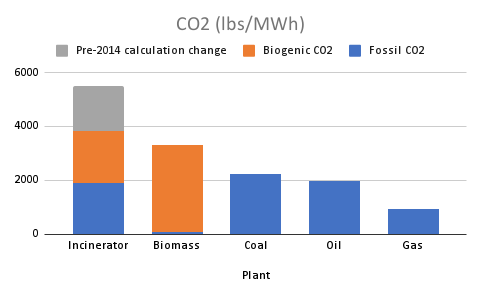
The corporate world knows that incinerators have a bad name. Even the most conventional trash incinerators will often dodge using that title, preferring “Energy-from-Waste,” “Waste-to-Energy” or “Trash-to-Steam.” In reality, these are really “Waste-OF-Energy” and “Trash-to-Toxic-Ash-and-Toxic-Air-Pollution” facilities. Read about how incinerators are NOT truly “waste-to-energy” facilities.
Here’s a list of alternative names for incinerators, processes which include incineration of some sort and incinerator-like processes. Some of these are specific types of incinerators:
- Trash-to-Steam
- Waste-to-Energy (WTE)
- Energy from Waste (EfW)
- Mass Burn
- Fluidized Bed [common types go by the acronyms CFB (circulating fluidized bed) or FBC (fluidized bed combustor)]
- Gasification
- Pyrolysis
- Pyromex
- Plasma Arc
- Catalytic cracking
- Microwave
- Thermal Oxidizer / Thermal Oxidation
- Landfill Gas-to-Energy (LFGTE)
- Flare
- Thermal Depolymerization
- Conversion technologies
- Thermal Treatment
- Advanced Thermal Technologies
- Biochar
- Biomass
- Boiler
- Furnace
- Afterburner
- Cogeneration
- Combined Heat and Power (CHP)
- Cement kilns
- Waste-to-fuel
- Fischer-Tropsch / Gas-to-Liquids (gasification/liquefaction)
- Cellulosic Ethanol (waste-to-ethanol)
Our Publications:
- New report: Beyond Incineration: Best Waste Management Strategies for Montgomery County, Maryland (March 2021) – debunks incinerator industry claims, and provides analysis showing incineration is worse than landfilling
- Incineration powerpoint presentation
- 274-group Letter to the Biden White House Council on Environmental Quality re: EPA’s pro-incineration policies (Oct 2022)
- Formal petition to U.S. EPA to require waste incinerators to report to the Toxics Release Inventory (April 2023) [petition with Public Employees for Environmental Responsibility and 313 groups in support]
- Factsheets:
- Trash Incineration Factsheet
- Incinerator Closures 2000-2024
- Trash Incineration and Environmental Racism
- Are landfills worse than incinerators for the climate?
- Life Cycle Analysis of Incineration vs. Landfilling
- Landfills are bad, but incinerators (with ash landfilling) are worse.
- Incinerator Health Studies (a response to Covanta’s flyer claiming that health studies find no impacts)
- Fact check on incinerator emissions (a response to Covanta’s Energy-from-Waste Emission flyer)
- Incinerator ash toxicity vs. NY soil cleanup standards
- Incinerator ash testing designed to make it “non-hazardous”
- Toxic hazards of construction and demolition waste incineration
Incineration is the most expensive and polluting way to make energy or to manage waste. It produces the fewest jobs compared to reuse, recycling and composting the same materials. It is the dirtiest way to manage waste – far more polluting than landfills. It is also the dirtiest way to produce energy – far more polluting than coal burning.
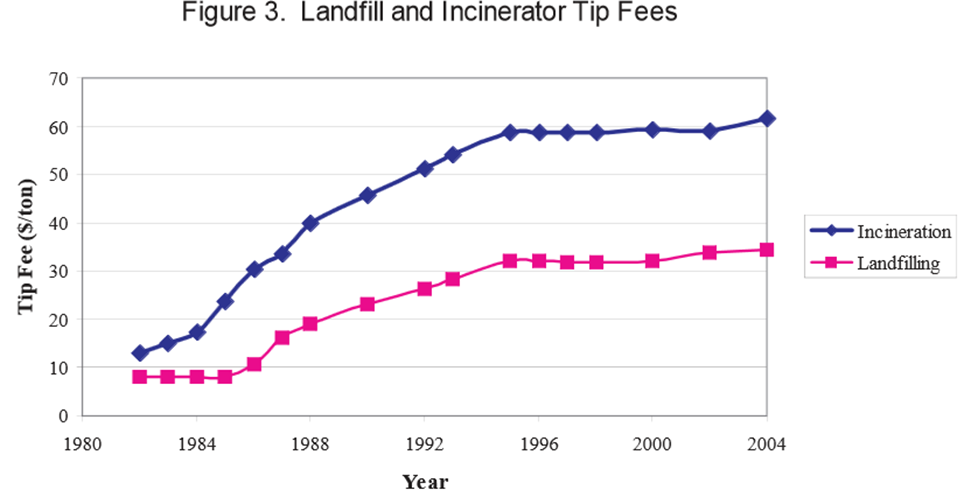 Most expensive way to manage waste
Most expensive way to manage waste
According to the waste industry itself, incineration has always been more expensive than landfills. They are inherently more complicated to operate and the cost gap increases over time as the enormous expense of pollution controls keeps incinerators expensive as air regulations gradually tighten. The cost of the 1,500 ton/day incinerator proposed for Frederick, MD (defeated in Nov 2014) climbed over $500 million — actually around $1 billion, including the interest on the bonds. A strong zero waste program could be developed for a fraction of the cost, diverting at least as much waste from landfills, as incinerators only reduce the tonnage going to landfills by 70% (about 90% by volume). Read more…
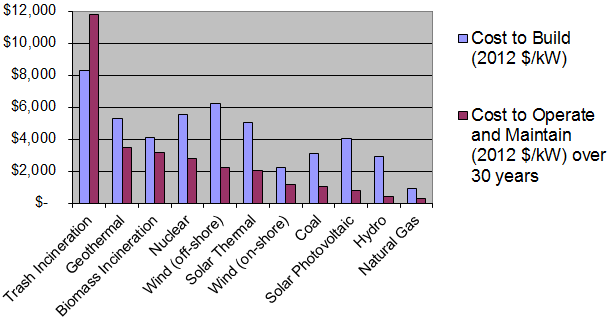 Most expensive way to make energy
Most expensive way to make energy
Trash incineration is the most expensive way to make energy, even though they get paid to take their fuel. This is true for the cost to build incinerators as well as the cost to operate and maintain them. Incineration is 2.7 times as expensive than coal to build and 11 times as expensive to operate and maintain. Nuclear power is one of the most expensive forms of energy and trash incineration is still 1.5 times as expensive to build and 4.2 times as expensive to operate and maintain than nuclear. This is according to the latest (April 2013) analysis done for the Energy Information Administration. Read more…
Incineration is not “waste-to-energy”
Waste-to-Energy is a PR term. Trash-to-steam is also a lie (there is more in trash than water, thus more in incinerator pollution than water vapor). The reality is that incinerators waste 3-5 times more energy than they recover, if you compare the energy produced through incineration to the embodied energy lost by not recycling and composting those materials, which must then be produced again from raw resources. Read more…
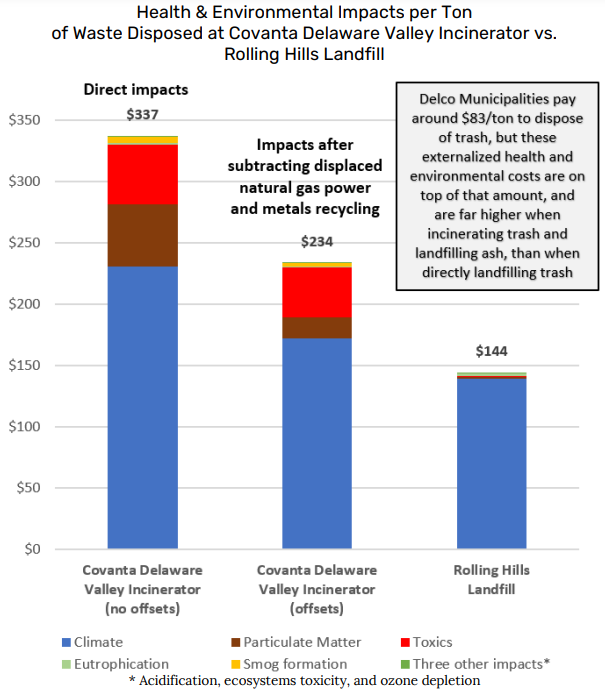
Bad for recycling and composting
The huge economic resources that need to be put into incineration are better spent on zero waste programs, which can reduce the amount of waste going to landfill by more than the 70% reduction in tonnage that incinerators accomplish — and can do so at lower cost. Once a incinerator is built, “put-or-pay” contracts discourage recycling and composting by charging local governments the same, even if they produce less waste.
Trash incinerators are unpopular and decliningNo new commercial trash incinerator has been sited, built and operated at a new site in the U.S. since 1995. One large new one, however, was built in West Palm Beach, Florida in 2015, adjacent to an existing large incinerator. Some smaller ones have also been expanded or rebuilt. Despite hundreds of attempts to build new incinerators, community opposition has been the main force preventing them from being built. Overall, the number of operating incinerators in the U.S. has declined. In 1991, there were 187 trash incinerators in the U.S. At the turn of the century, there were 114. As of March 2024, not counting some truly tiny ones, there are just 65, the lowest number since 1980. See our factsheet on incinerator closures.
Number of Commercial Trash Incinerators Operating in the U.S.
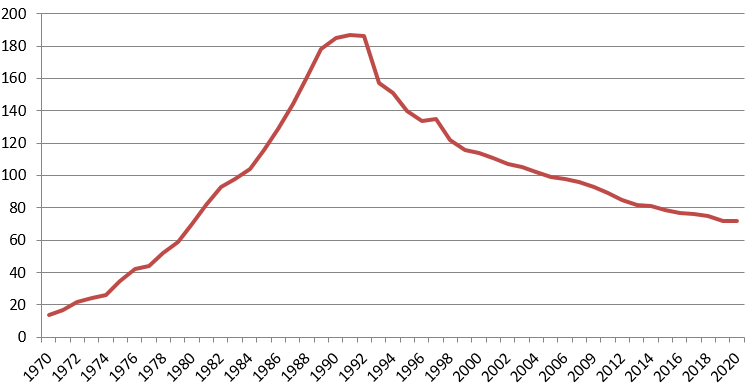
General resources against incineration:
- The Health Effects of Waste Incinerators: 4th Report of the British Society for Ecological Medicine (June 2008) [related documents here]
- Waste Not newsletter archive (chronicles 1990s U.S. grassroots movement against trash incinerators)
U.S. Trash Incinerator Lists and Maps
- List of Operating Commercial Trash Incinerators in the U.S. by size
- Hand-drawn maps by John van der Harst (2001)
- U.S. Map (2001)
- Eastern U.S. Map (closer up)
- Energy Justice Network Mapping Project:
- Operating U.S. Trash Incinerators
- Mapping Project Home
(enter your zip code or use national or global maps or search features to find various types of incinerators)
Incinerator-related issues:
Fluidized Bed Combustors (FBCs)
- Waste Coal Burners (which use FBCs)
- Summary of Studies on Emissions of Polycyclic Aromatic Hydrocarbons (PAHs) and Nitrous Oxide (N2O) and Carbon Monoxide (CO) from Waste Coal Fluidized Bed Combustors (FBCs)
- Waste Coal Burner Powerpoint Presentation
- Tire incineration in fluidized bed boilers
Incinerators-in-Disguise (Gasification / Plasma / Pyrolysis):
- GAIA Publications:
- Incinerators-in-Disguise Powerpoint (Greenaction, Aug 2014)
- Waste Conversion Technologies: Emergence of a New Option or the Same Old Story? (2007 report for New York State solid waste industry, explaining plasma and gasification processes, their pitfalls and lists of existing facilities in the world)
- Waste Gasification: Impacts on the Environment and Public Health (Blue Ridge Environmental Defense League, 2009 report on Pyrolysis and Gasification)
- Pyrolysis and Thermal Gasification of Municipal Solid Waste (Blue Ridge Environmental Defense League, 2002)
Gasification
- “Litany of Gasification Failures” (2016 compilation by UK Without Incineration Network)
- Evaluation of Emissions from Thermal Conversion Technologies Processing Municipal Solid Waste and Biomass [direct link] (2009 report by University of California at Riverside for the BioEnergy Producers Association; includes global list of gasification facilities at end of report)
- Comments on the proposed modification of the Massachusetts Solid Waste Management Plan to lift the moratorium on solid waste incineration and allow development of gasification power plants, Partnership for Policy Integrity
- Coal Gasification / IGCC
- Poor Track Record of Trash Gasification Plants (Sept 2002 letter)
- Trash Gasification Emissions (April 2002 letter)
- EPA Report: Gasifier Ash Contaminates Ground Water
One myth around the solid wastes produced by gasification is that they are a glass-like “slag” that never leaches. Of course, even conventional trash incinerators pretend that their highly toxic and leachable ash never leaches. With gasification systems, they still produce ash that can leach toxic chemicals into the groundwater where it is dumped. Unlike conventional incinerator ash (which mostly goes to landfills), gasification promoters often claim that they’ll sell their “slag” as building material, soil amendment or aggregate. The ash is still full of toxic metals, halogens and radioactive elements that were present in the waste and which can’t be destroyed. Data from coal gasification slag produced in a coal gasification facility in North Dakota shows serious groundwater contamination from leaching and is noted in this EPA report on groundwater “damage cases” from ash/slag disposal sites. See pages 82-83.
Plasma Arc
Pyrolysis
- Video explaining reality of Pyrolyzer, LLC’s pyrolysis proposal for Logansport, IN (original Prezi presentation shown in video is here)
- In Feb. 2014, the state of Delaware determined that a pyrolysis proposal is incineration under the state’s law that bans incineration from within 3 miles of a residence, church, school, park, or hospital — which is basically the entire state. See background on ReNew Oil’s proposed tire and plastics pyrolysis plant. More details on the state’s decision are in their June 2013 letter stating that the pyrolysis process meets the state’s definition of incineration.
- Biochar
Cellulosic Ethanol, Fischer-Tropsch Coal-to-Liquids, Thermal Depolymerization and Waste-to-Fuels:
- For many of these alternative types of incinerators and conversion processes (waste-to-fuels), see some of the basic arguments forth in our alternative fuels factsheet.
Tire Incineration:
- Tire Incineration
- Tire incineration in fluidized bed boilers
- Cement kilns (burning of hazardous waste and tires)
Biomass and Landfill gas:
- Biomass Incineration
- Biomass Incineration Factsheet
- Poultry Litter Incineration
- Landfill Gas
- Landfill Gas and Biomass Powerpoint Presentation
Cement Kilns:
Incineration Definitions
The industry tries hard to pretend that plasma, gasification and pyrolysis are not forms of incineration. However, the European Union and the United States have defined all these technologies as forms of incineration (emphasis added).
The European Union defines incinerators as follows:
‘incineration plant’ means any stationary or mobile technical unit and equipment dedicated to the thermal treatment of wastes with or without recovery of the combustion heat generated. This includes the incineration by oxidation of waste as well as other thermal treatment processes such as pyrolysis, gasification or plasma processes in so far as the substances resulting from the treatment are subsequently incinerated.
This definition covers the site and the entire incineration plant including all incineration lines, waste reception, storage, on site pretreatment facilities, waste-fuel and air-supply systems, boiler, facilities for the treatment of exhaust gases, on-site facilities for treatment or storage of residues and waste water, stack, devices and systems for controlling incineration operations, recording and monitoring incineration conditions;
‘co-incineration plant’ means any stationary or mobile plant whose main purpose is the generation of energy or production of material products and: — which uses wastes as a regular or additional fuel; or — in which waste is thermally treated for the purpose of disposal.
Article 3 of Directive 2000/76/EC of the European Parliament and the Council of 4 on the incineration of waste (see page 4)
For more info on the EU’s Waste Incineration Directive, see the UK Environment Agency’s website on waste incineration.
In the United States, the definition of “municipal waste combustor” (trash incinerator) includes gasification and pyrolysis:
In Feb 11, 1991, U.S. EPA published regulations in the Federal Register (56 FR 5488) that state:
Municipal waste combustor or MWC or MWC unit means any device that combusts, solid, liquid, or gasified MSW including, but not limited to, field-erected incinerators (with or without heat recovery), modular incinerators (starved air or excess air), boilers (i.e., steam generating units), furnaces (whether suspension-fired, grate-fired, mass-fired, or fluidized bed-fired) and gasification/combustion units. This does not include combustion units, engines, or other devices that combust landfill gases collected by landfill gas collection systems.
[MSW = Municipal Solid Waste (household and commercial trash)]
This regulation (40 CFR 60.51a) was later revised on Dec. 19, 1995 to include pyrolysis, making gasification part of a new pyrolysis definition:
Municipal waste combustor, MWC, or municipal waste combustor unit: (1) Means any setting or equipment that combusts solid, liquid, or gasified MSW including, but not limited to, field-erected incinerators (with or without heat recovery), modular incinerators (starved-air or excess-air), boilers (i.e., steam-generating units), furnaces (whether suspension-fired, grate-fired, mass-fired, air curtain incinerators, or fluidized bed-fired), and pyrolysis/combustion units. Municipal waste combustors do not include pyrolysis/combustion units located at plastics/ rubber recycling units (as specified in § 60.50a(k) of this section). Municipal waste combustors do not include internal combustion engines, gas turbines, or other combustion devices that combust landfill gases collected by landfill gas collection systems.
Pyrolysis/combustion unit means a unit that produces gases, liquids, or solids through the heating of MSW, and the gases, liquids, or solids produced are combusted and emissions vented to the atmosphere.
If there is any doubt that a “municipal waste combustor” is an incinerator, the U.S. Environmental Protection Agency clearly states that they’re the same thing: “A municipal waste incinerator ‘combusts’ solid waste and thus is functionally synonymous with municipal waste combustor.” See: http://www.epa.gov/ttn/nsr/gen/rm_2.html
Regarding landfill gas burners: while not regulated as “municipal waste combustors,” landfill gas burners have also been referred to as incinerators by those in the industry, the trade press, county waste facility managers, and the federal government’s National Renewable Energy Laboratory.
Also, U.S. EPA Hazardous Waste Regulations (40 CFR 260.10) also state that plasma arc is an incineration technology:
Incinerator means any enclosed device that:
(2) Meets the definition of infrared incinerator or plasma arc incinerator.
Infrared incinerator means any enclosed device that uses electric powered resistance heaters as a source of radiant heat followed by an afterburner using controlled flame combustion and which is not listed as an industrial furnace.
Plasma arc incinerator means any enclosed device using a high intensity electrical discharge or arc as a source of heat followed by an afterburner using controlled flame combustion and which is not listed as an industrial furnace.
Industrial furnace means any of the following enclosed devices that are integral components of manufacturing processes and that use thermal treatment to accomplish recovery of materials or energy:
(1) Cement kilns
(2) Lime kilns
(3) Aggregate kilns
(4) Phosphate kilns
(5) Coke ovens
(6) Blast furnaces
(7) Smelting, melting and refining furnaces (including pyrometallurgical devices such as cupolas, reverberator furnaces, sintering machine, roasters, and foundry furnaces)
(8) Titanium dioxide chloride process oxidation reactors
(9) Methane reforming furnaces
(10) Pulping liquor recovery furnaces
(11) Combustion devices used in the recovery of sulfur values from spent sulfuric acid
(12) Halogen acid furnaces (HAFs) for the production of acid from halogenated hazardous waste generated by chemical production facilities where the furnace is located on the site of a chemical production facility, the acid product has a halogen acid content of at least 3%, the acid product is used in a manufacturing process, and, except for hazardous waste burned as fuel, hazardous waste fed to the furnace has a minimum halogen content of 20% as-generated.
(13) Such other devices as the Administrator may, after notice and comment, add to this list on the basis of one or more of the following factors:

